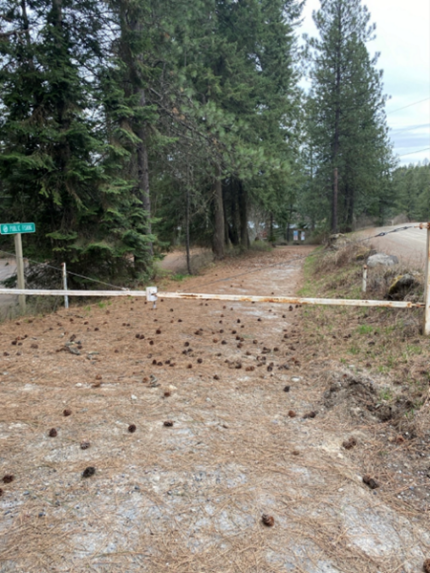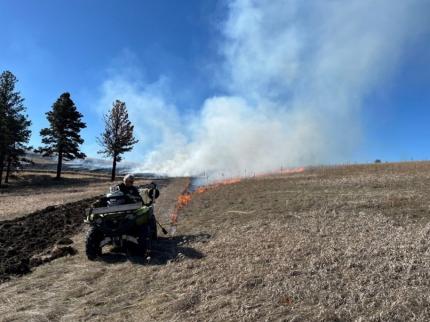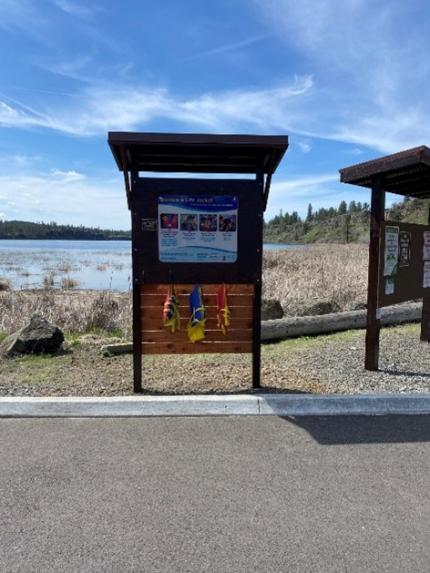Managing Wildlife Populations
Golden Eagle Mortality: Biologist Brinkman coordinated with the wildlife program manager from the Spokane Tribe that found a deceased golden eagle with a GPS transmitter on the Spokane Reservation. This coordination also included Washington Department of Fish and Wildlife (WDFW) Biologist Vekasy, Wildlife Research Scientist Watson, and a biological consulting organization to determine the owner of the transmitter and learn about the history of the bird. They discovered the bird was marked in 2017 and provided five years of location data before the transmitter stopped functioning. Samples will be submitted to examine lead exposure levels.
Moose Mortality Notification: The moose team received a mortality notification for one of the cow moose collared in February. Biologist Brinkman met with three other WDFW biologists from the moose team to investigate the location of the mortality signal. The cow moose carcass was found intact with no evidence of predator activity. The team of biologists conducted a full field necropsy and collected samples that will be sent to the Washington Animal Disease Diagnostic Lab (WADDL) for analysis and determination of cause of death.

Providing Recreation Opportunities
Access Areas: North Region 1 Water Access Area Manager Dziekan and Natural Resource Technician Brant have been busy cleaning access area restrooms in preparation for spring fishing and boating season. The work included picking up litter and cleaning restrooms, and they used backpack blowers to clear the parking areas of pine needles and other debris that accumulated during the winter. Backpack blowing is very much a routine task, but this scale of backpack blowing takes a lot of time.


Conserving Natural Landscapes
Controlled Burning: Wildlife area staff members conducted controlled burns of agricultural fields on Smoothing Iron Ridge. They burned wheat stubble off food plot fields in preparation for weed control and spring plantings. They also burned off a perennial grass field due to increasing ventenata and to stimulate new perennial grass growth for the elk. This project was not completed due to the rain so staff members will need to finish it up once nicer weather arrives.



Weed Control: Biologist Woodall sprayed parking and access sites on Cloverland and Meyers Ridge roads. He also coordinated with a contractor who completed an aerial spray project for Mediterranean sage.

Tire Cleanup: Wildlife Area Manager Dingman contacted Columbia County Road Department about disposing of approximately 40 tires and a dryer that were picked up along Hartsock Grade by wildlife area staff members. The county covered the transfer station cost to dispose of everything since it is a county road and right-of-way. Tritt hauled the full dump trailer to the Columbia County transfer station and disposed of the tires and dryer.
Noxious Weed Control: Natural Resource Technicians Jensen and Tritt started spraying the field along Oliphant Road for yellow star thistle and houndstongue. They also sprayed weeds in the area of the Rainbow Lake spoils pile and the field by Campground 2. Tritt repaired one of the all-terrain vehicle spray tanks so all three sprayers are now functioning. Wildlife Area Manager Dingman sprayed weeds around the headquarters fields. Dingman set up some monitoring plots in upper Tumalum Creek for future monitoring of noxious weed infestations.
Habitat Planting: Natural Resource Technician Moberg assisted Private Lands Biologist Thorne-Hadley in planting 120 shrubs on private land that is enrolled in an access agreement program. The landowner tagged along and showed us an additional site with a water guzzler that would be an ideal candidate for future habitat work.
Hunting Access Programs: Natural Resource Technician Moberg and Private Lands Biologist Thorne-Hadley investigated a 2,000+ acre property whose owner has expressed interest in joining the private lands access program. Moberg also met with a representative of Puget Sound Energy to learn more about the Columbia County Windfarm Recreation access program.
Habitat Plots and Plantings: Private Lands Biologist Nizer met with a landowner to mow a food plot with the tractor and prepared another site for a planting. Nizer also led a crew to plant 1,700 trees for turkey roosting habitat. In total, there were five volunteers for the Saturday project. Nizer also met with Private Lands Biologist Baarstad to plant 1,000 shrubs on a Hunt by Written Permission property.

Providing Education and Outreach
Trent Elementary: Biologist Brinkman gave a presentation to fifth grade students at Trent Elementary School about moose biology and management in Washington.

Eagle Scout Project: Wildlife Area Access Manager Dziekan worked with a local boy scout troop to complete an eagle scout project. They installed a personal flotation device loaner station at the Williams Lake Water Access Area.

Conducting Business Operations and Policy
Riparian Shrub Planting Project: This past week a freight company delivered eight rolls of deer fence that the Spokane Audubon Society purchased for the upcoming riparian winter shrub habitat project at Swanson Lakes Wildlife Area. The Spokane Audubon Society will also be purchasing all the shrubs for the project which makes their total donation over $8,200. The Spokane Chapter of Pheasants Forever will also be involved with their volunteers and funding. There will be approximately 780 trees and shrubs planted and then enclosed with deer fence to protect them from deer and possibly trespassing cattle.